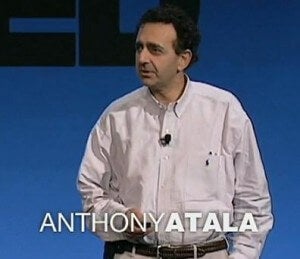
“Every thirty seconds a patient dies from diseases that could be treated with tissue replacement.” That was one of the first things that Anthony Atala told his TEDMED audience in October 2009. It’s an alarming statistic that gives insight into the determined and passionate work that Atala pursues at his Wake Forest Institute for Regenerative Medicine. Atala and his team have been developing the means to restore the human body after injury and disease. Biomaterials, bio-reactors, stem cells, growing organs on collagen scaffolds…if it can provide you with a replacement organ, chances are that Wake Forest has tried it. Their results are truly impressive, and it’s no wonder that Atala’s talk was one of Alexandra Carmichael’s Top 10 Innovations at TEDMED 2009. After the break is the video of Atala’s 18 minute presentation. Don’t miss a second of it.
For those with limited bandwidth, or an employer who doesn’t want you watching amazing medical videos, here’s a brief list of contents followed by the video:
1:46 – Atala alerts the audience to the scope of the problems with organ transplants and limited organs. Starting with the quote from above.
2:28 – An interesting time-elapsed video of a salamander regrowing a fore-limb.
3:55 – Biomaterials can act as a bridge to encourage tissue growth over damaged areas or gaps. The bridge length, however, is limited to about 1 cm.
5:15 – Using cells that are cultured outside the body, Atala can take an artificial scaffold and create a new organ.
6:20 – Atala uses a bio-reactor to exercise and condition muscle tissue before it is placed in a patient. It’s really amazing to watch the tissue be stimulated outside the body.
6:58 – The same techniques can be used to create engineered blood vessels.
8:30 – The Wake Forest team can take cell samples to create an engineered bladder and place it into a patient in just six to eight weeks!
9:50 – Is a bladder not impressive enough for you? Check out this heart valve that Atala’s team grew and then exercised in a reactor.
10:12 – Ok…This is just incredible. Watch as Atala shows you an artificially grown ear! And then a few seconds later, the bones of a finger!
11:03 – Here we get to a demonstration that has generated a lot of interest. Using a common inkjet printer, the Wake Forest Institute can print muscle cells into tissue. The two chambered heart shown here is still very experimental and not for use in patients.
11:50 – Another possible means of regrowing tissue is to take donor organs and strip them of everything but collagen. This scaffold is then used as a base to grow a new organ from a patient’s own cells. We’ve seen this with stem cells and hearts, and also with a trachea.
13:20 – 90% of patients waiting for organs in the US need a kidney. The Wake Forest team has used wafers of cells to create miniature kidneys that are still in the test phase.
13:58 – Atala discusses strategies in regenerative medicines.
15:37 – The progression of developing these new medical techniques will not be easy.
16:55 – Atala ends with an example of how the (relatively) long history of regenerative medicine has already helped the lives of patients.
Watching the amazing examples of Atala’s work really makes me hopeful for the future of medicine. We’ve discussed many of these innovations before, but he places them all in a larger context that highlights the many possible approaches scientists have created to help save us from organ failure. There isn’t just one solution here. While some, like organ printing on an inkjet, are more fantastical than others, each technique gives us a means to help repair the damage caused by living and aging. Together they demonstrate how regenerative medicine is set to alter the way that humans view the limitations of their bodies.
Talks like this one are why I love TED. Stay tuned to Singularity Hub as we’ll keep you posted as more videos from this extraordinary conference are released each week.
[screen capture and video credit: TEDMED 2009]


